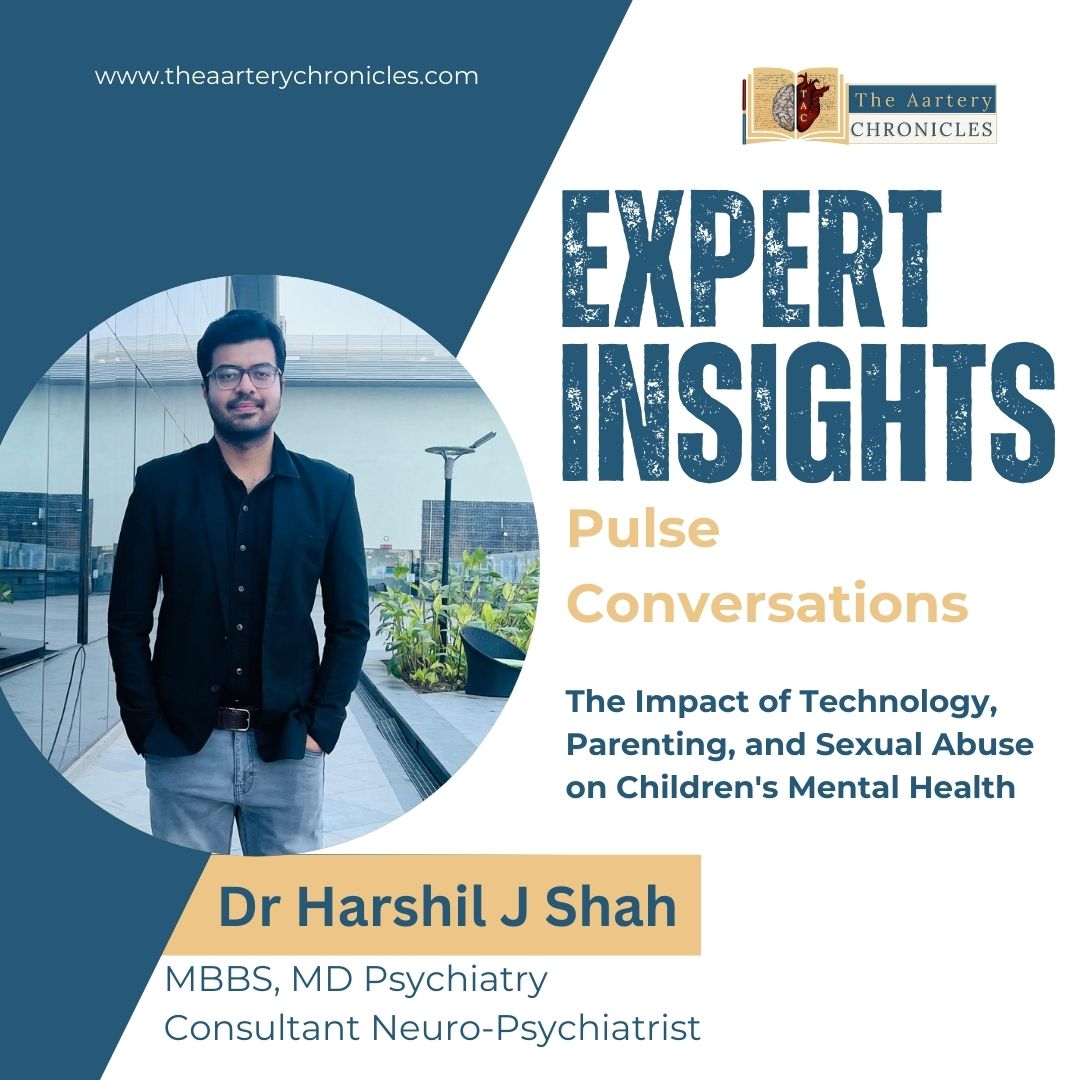

Expert Insights: The Impact of Technology, & Sexual Abuse on Children's Mental Health
Overview
Mental health disorders have traditionally been associated with adults, but in recent years, there has been a noticeable rise in these conditions among children and adolescents.
To understand the complexities behind this trend, Dr. Harshil J Shah, an esteemed psychiatrist, highlights three major factors contributing to the rise of mental health issues in children: the surge in cell phone usage, dysfunctional parenting patterns, and the often-hidden issue of childhood sexual abuse.
These factors create significant emotional and psychological challenges for children, affecting their development and mental well-being.
In a conversation with The Aartery Chronicles, Dr. Harshil J Shah, (MBBS, MD Psychiatry) an esteemed psychiatrist affiliated with Apollo Hospitals, delves into the impact of Technology, Parenting, and Sexual Abuse on Children’s Mental Health
The Impact of Cell Phones on Children’s Mental Health
Dr. Harshil J Shah explains that the widespread use of cell phones, even among very young children, is a growing concern. Many parents use phones as a tool to manage their children’s tantrums and to avoid public scenes. However, this pattern sets a negative precedent, where children associate their outbursts with receiving a reward—access to a phone. This behavior reinforces the idea that throwing tantrums leads to getting what they want, which can result in a long-term negative pattern.
He further elucidates that another significant concern is the content children are exposed to on these devices. While young users may be adept at navigating phones, they often lack the maturity to discern between appropriate and harmful material. Without proper parental monitoring, children may encounter explicit or negative content. This can have detrimental effects on their mental and emotional development and result in long-lasting issues that may not be immediately apparent.
Parenting Patterns and Their Role on Children’s Mental Health
Dr. Harshil J Shah emphasizes that parenting styles also play a crucial role in shaping a child’s mental health. Dysfunctional family dynamics, such as constant conflict between parents or unresolved marital issues, can leave a lasting impression on children. For instance, if a child grows up witnessing frequent arguments or even a turbulent divorce, the emotional strain of these experiences can contribute to anxiety, depression, or behavioral issues.
Children in such environments often feel confused, helpless, or insecure, and their mental health can deteriorate as a result. In some cases, these family issues can lead to substance abuse or neglect, further exacerbating the child’s mental health problems.
The Hidden Trauma of Sexual Abuse
Dr. Shah highlights that another critical factor affecting children’s mental health is sexual abuse, a largely hidden issue that often goes unreported. Many children, especially younger ones, may not fully comprehend the trauma they have experienced at the time, leading to delayed emotional and psychological effects. This delayed recognition of abuse often manifests as symptoms of PTSD (post-traumatic stress disorder) later in life.
Dr. Shah recounts cases where young children, particularly girls, were initially unaware of the nature of the abuse they had experienced. It was only years later, as they matured and understood the gravity of what had happened, that they began to develop emotional and psychological symptoms. This delayed awareness often triggers trauma responses, such as anxiety, depression, or PTSD, highlighting the long-lasting impact of early abuse on mental health.
The lack of maturity and awareness at the time of the abuse makes it difficult for children to express their feelings or seek help. This delayed reaction to trauma is a serious issue, requiring vigilance and support from parents and mental health professionals.
How to Prevent Mental Health Issues in Children?
To mitigate these risks, Dr. Shah emphasizes the importance of parental supervision and setting healthy boundaries regarding technology use. Parents should monitor what their children are exposed to on their devices and establish limits on screen time. In addition, it is essential for parents to be aware of the signs of mental health issues in children, as these signs often differ from those in adults.
Common indicators of mental distress in children may include social isolation, declining academic performance, frequent tantrums, and a lack of interest in school or other activities. Children may not explicitly express their emotions by saying they are depressed, but their behavior can serve as a signal that something is wrong.
By fostering open communication, maintaining a stable home environment, and paying close attention to behavioral changes, parents can help safeguard their children’s mental health and address issues before they become more severe.
Conclusion
In conclusion, Dr. Harshil J Shah emphasizes the importance of recognizing the multifaceted factors contributing to the rise of mental health issues in children and adolescents. From the negative impact of excessive cell phone use and dysfunctional parenting patterns to the hidden trauma of sexual abuse, it is crucial for parents, educators, and healthcare professionals to remain vigilant. Early intervention, healthy boundaries, and open communication are key in supporting children’s mental health and preventing long-term psychological consequences.









